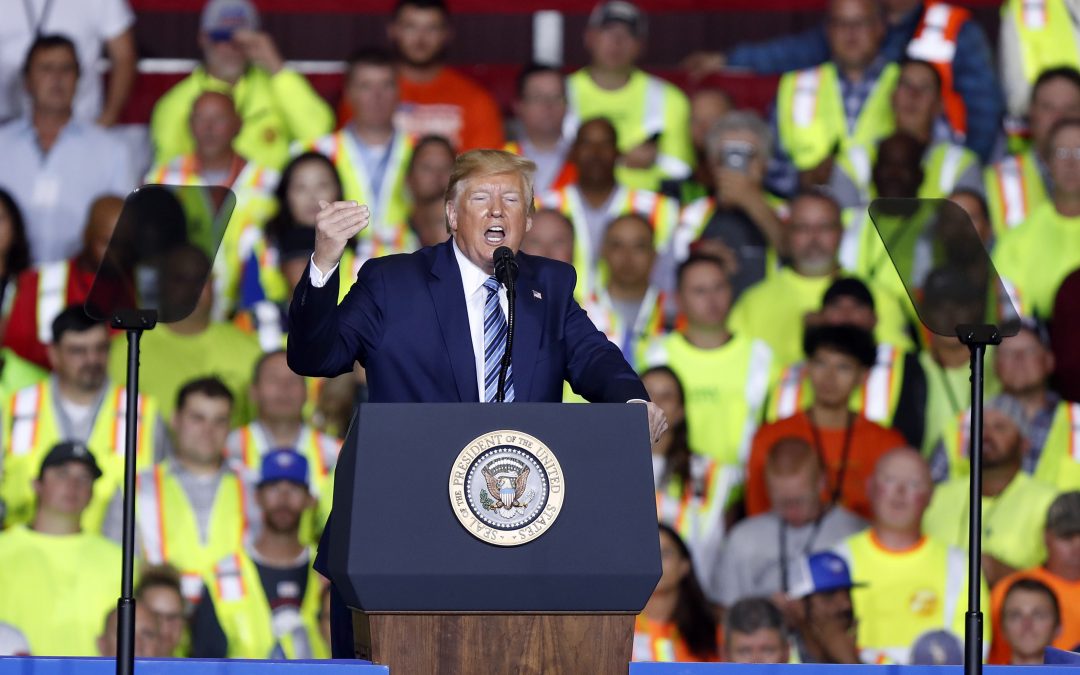Donald Trump was applauded yesterday when he took credit for a major manufacturing complex being built in western Pennsylvania, but the truth is the plans were announced during the Obama administration.
He was cheered on by fluorescent-vest-clad workers who were paid to attend by Shell, their employer, which is building the facility.
It’s Trump’s latest effort to reinvigorate the Rust Belt support that sent him to the White House.
As for the new complex, he declared, “This would have never happened without me and us.”
Despite Trump’s claims, Shell announced its plans to build the complex in 2012, midway through President Obama’s term in the White House.
The event was billed as an official White House event, but Trump turned much of it into a campaign-style rally, boasting of achievements he claims as president and assailing his would-be Democratic rivals for the 2020 election.
Trump was visiting Shell’s soon-to-be completed Pennsylvania Petrochemicals Complex, which will turn the area’s vast natural gas deposits into plastics.
The facility is being built in an area hungry for investment and employment, though critics claim it will become the largest air polluter in western Pennsylvania.
Trump contends that America’s coal, oil and manufacturing are reviving and he deserves the credit.
He’s been focusing on his administration’s efforts to increase the nation’s dependence on fossil fuels in defiance of increasingly urgent warnings about climate change.
And he’s embracing plastic at a time when the world is sounding alarms over its impact.
“We don’t need it from the Middle East anymore,” Trump said of oil and natural gas, proclaiming the employees “the backbone of this country.”
Trump’s appeals to blue-collar workers helped him win Beaver County, where the plant is located, by more than 18 percentage points in 2016, only to have voters there turn to Democrats in 2018′s midterm elections.
In one of a series of defeats that led to Republicans’ loss of the House, voters sent Democrat Conor Lamb to Congress after the prosperity promised by Trump’s tax cuts failed to materialize.
Today, the much of the area is still struggling to recover from the shutting of steel plants in the 1980s that sent unemployment to nearly 30%.
Former mill towns like Aliquippa have seen their population shrink, though Pittsburgh has lured major tech companies like Google and Uber, fueling an economic renaissance in a city that reliably votes Democratic.
Trump claimed that his steel and aluminum foreign-trade tariffs have saved the industries and that they are now “thriving,” exaggerating the recovery of the steel industry, particularly when it comes to jobs, which have largely followed pace with broader economic growth.
Trump took credit for the addition of 600,000 U.S. manufacturing jobs.
Labor Department figures show that roughly 500,000 factory jobs have been added since his presidency started.
Manufacturing has also started to struggle anew this year as the administration has intensified its trade war with China and factory production has declined.
Pennsylvania has lost 5,600 manufacturing jobs so far this year, according to the Labor Department.
The project currently has 5,000 construction workers.
Once operational, however, the number of permanent employees at the site will shrink to 600.
The area still faces economic headwinds.
The nearby Beaver Valley Power Station, a nuclear plant that has employed 850 people, has announced plans to close in 2021.
And the Bruce Mansfield Power Plant, once the state’s largest coal-powered plant, announced Friday that it would close this fall, 19 months earlier than expected, at a cost of at least 200 jobs.
